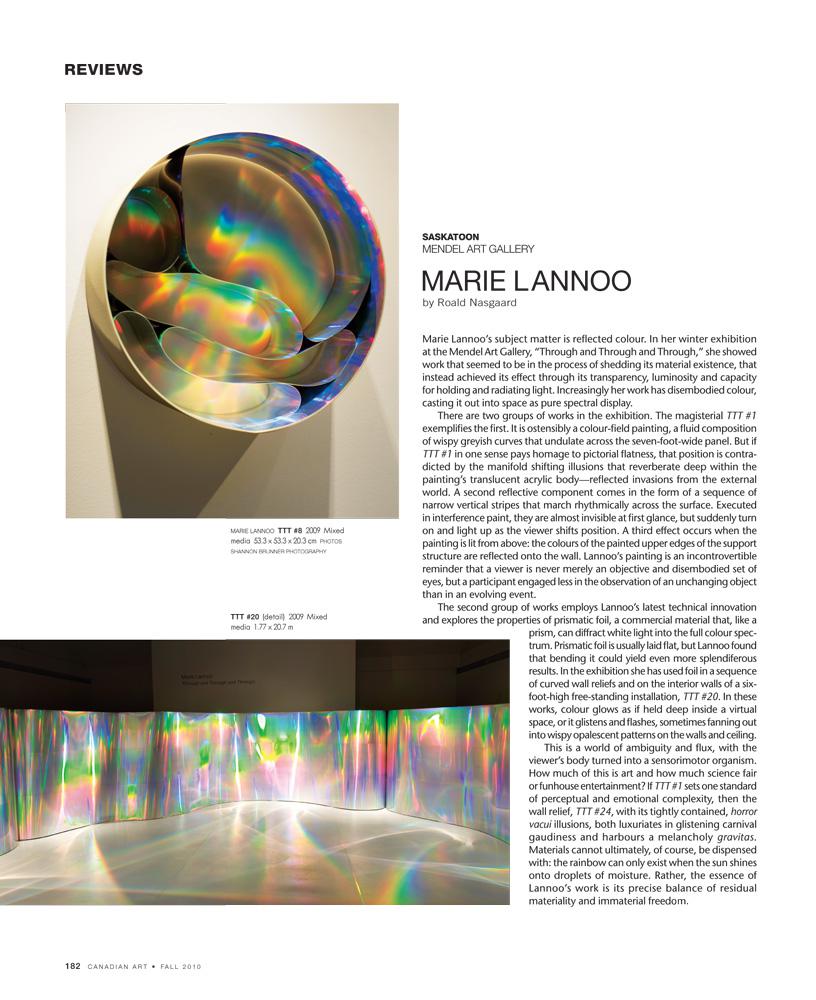Marie Lannoo’s subject matter is reflected colour. In her winter exhibition at the Mendel Art Gallery, “Through and Through and Through,” she showed work that seemed to be in the process of shedding its material existence, that instead achieved its effect through its transparency, luminosity and capacity for holding and radiating light. Increasingly her work has disembodied colour, casting it out into space as pure spectral display.
There are two groups of works in the exhibition. The magisterial TTT #1 exemplifies the first. It is ostensibly a colour-field painting, a fluid composition of wispy greyish curves that undulate across the seven-foot-wide panel. But if TTT #1 in one sense pays homage to pictorial flatness, that position is contradicted by the manifold shifting illusions that reverberate deep within the painting’s translucent acrylic body—reflected invasions from the external world. A second reflective component comes in the form of a sequence of narrow vertical stripes that march rhythmically across the surface. Executed in interference paint, they are almost invisible at first glance, but suddenly turn on and light up as the viewer shifts position. A third effect occurs when the painting is lit from above: the colours of the painted upper edges of the support structure are reflected onto the wall. Lannoo’s painting is an incontrovertible reminder that a viewer is never merely an objective and disembodied set of eyes, but a participant engaged less in the observation of an unchanging object than in an evolving event.
The second group of works employs Lannoo’s latest technical innovation and explores the properties of prismatic foil, a commercial material that, like a prism, can diffract white light into the full colour spectrum. Prismatic foil is usually laid flat, but Lannoo found that bending it could yield even more splendiferous results. In the exhibition she has used foil in a sequence of curved wall reliefs and on the interior walls of a sixfoot- high free-standing installation, TTT #20. In these works, colour glows as if held deep inside a virtual space, or it glistens and flashes, sometimes fanning out into wispy opalescent patterns on the walls and ceiling.
This is a world of ambiguity and flux, with the viewer’s body turned into a sensorimotor organism. How much of this is art and how much science fair or funhouse entertainment? If TTT #1 sets one standard of perceptual and emotional complexity, then the wall relief, TTT #24, with its tightly contained, horror vacui illusions, both luxuriates in glistening carnival gaudiness and harbours a melancholy gravitas. Materials cannot ultimately, of course, be dispensed with: the rainbow can only exist when the sun shines onto droplets of moisture. Rather, the essence of Lannoo’s work is its precise balance of residual materiality and immaterial freedom.
This is an article from the Fall 2010 issue of Canadian Art. To read more from this issue, please visit its table of contents.

 Spread from the Fall 2010 issue of Canadian Art
Spread from the Fall 2010 issue of Canadian Art







